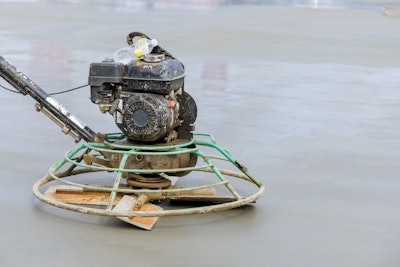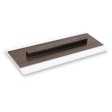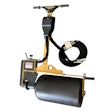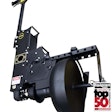
After the screed and rakes get the concrete where it needs to be, it’s the power trowel that puts that finishing touch. Those spinning blades of the power trowel are where contractors can get that smooth, near-mirror finish.
Here are 5 things concrete contractors should know and understand about their power trowel blades.
1. Ensure the blade and machine match.
This is an obvious entry here, but it’s vital, so we're putting it first.
There are two camps of power trowel blades. One group features a pattern to allow it to fit the majority of machines. The other group is proprietary. These blades can only be mounted on the brand of power trowel they were designed.
Here, size matters. Fits are based on bolt pattern and ensure the blade length is the correct measurement for the machine and rotor. Some common blade lengths are:
| Rotor Size | Blade Length |
|---|---|
| 36 in. | 14 in. |
| 46 in. | 16 in. or 18 in. |
| 60 in. | 23 in. |
Many manufacturers and suppliers have fit guides. Use the power trowel model number to find what will work for your machine.
Make sure to note the thickness of the blade. The thicker the blade, the more life. The thinnest blades are typically called “Silver.” “Blue Steel” is a mid-range. “Golden Steel” is thicker.
There are too many variables in play to confidently state how long a blade may last. The weight of the machine, the pitch of the blade, how much pressure was placed on the blade, the type of concrete, etc., all affect their life. There isn’t a linear number to say “this thickness should provide this many square feet.”
Ultimately, all you can do is track what that blade and gone through and inspect after the job. Keeping them clean and in good operating shape is key to getting the most work out of your investment.
2. Maintaining Your Blade
It’s important to keep a power trowel blade clean to get it to last as long as possible.
- Use a water hose and brush to clean off the slurry from the top and bottom of the blades as much as possible.
- Ensure the bolts are as clean as you can. If necessary, chip off the concrete to get to the mounting bolts to change them.
- Some contractors spray a form oil to keep the rust off
- Spray off the bottom of the trowel and rotor to help keep concrete from sticking
3. When to Replace
Replace a power trowel blade when it starts to become thin, like paper-thin. At the point where the blade is tilted — where it comes into contact with the concrete — the steel will begin to flake, and pieces will fray. If the blade is reversible, it's time to flip it around.
Don’t worry about measuring; a worn-out blade will be obvious. You may even be able to flick away the steel with a finger.
4. Plastic
Plastic blades are a similar story. A plastic power trowel blade should be able to do the exact same job as its steel counterpart, but without burnish the concrete. “Burnishing is the friction of a steel blade on the concrete, leaving dark marks, spots, or darkening the whole slab,” explains Jim Bowie, category sales director of MARSHALLTOWN. Plastic won’t.
Picture the shiny, finished surface of your nearby store. Floating a slab with a plastic blade should produce a clear finish.
The drawback with a plastic power trowel blade is the additional cost and shorter life. It’s recommended to find out if the slab will have foot traffic or if the quality is an architectural feature.
5. Float & Finish
Floating the concrete happens when concrete is still plastic. Floating flattens the surface a bit more and more with each pass of work to get that nice, smooth surface everyone strives for. In short, the high spots are being taken down and the low spots are being filled in.
There are two ways to accomplish this: float shoes or a combination blade. Float shoes are old school. These clip onto a finish blade — some add enough width to the blade to almost double the working area. Once done, the shoe unclips from the finish blade. Second is the combination blade. These are also wider than a finish blade but allow contractors to float the surface but also finish the concrete when the blades are pitched up as the concrete hardens.
Both are still used today, but the combination blade has been a more popular option for decades.
Notice that both essentially make the finish blade wider. This is key. The more surface of the blade on the concrete — or the more steel — the flatter the slab. If a combination bade is set more flat, it’ll float. When tilted up, it’ll finish.
Bonus: Pans
Used in combination with a finished blade, a pan is a large disc designed to make the slab even more level. This one spinning disc (per rotor) will level out a larger surface of concrete all at once. They are typically designed to clip onto the blades themselves, be clipped off to finish, and then be put back on before putting the machine onto the trailer.
Remember, like fitting the blade to the machine, many manufacturers and suppliers have guides to list the correct pan size.





